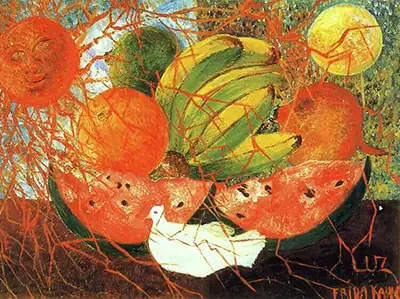It depicts sliced watermelons, oranges, and bananas sitting on a wooden bench. The sun and moon are also seen in its background with thorns surrounding the fruits. She occasionally used fruits from her garden and local market as the subjects of her paintings. Since she was mostly bedridden, this was the most suitable way for her to arrange the fruits by her bedside. Some symbolism can be spotted in the painting which she used to highlight political influences from her time. This can be seen by the use of peace doves and inscriptions to send out messages to the public.
The painting also symbolizes the fertility of her motherland Mexico. The theme that is brought up in this piece surrounds her life experience which is common in all her paintings. She would portray the pain she felt with her body and her marriage to artist Diego Rivera. The strokes especially done on the thorns can portray her releasing her pain as a form of expression. The painting is done using oils on a material known as Masonite. Masonic was quite a popular material made in the 1920s which is a smooth hardboard that required little attention before application of paint. Masonite is a manufactured from wood broken down to fibers and redistributed to form the hard surface to facilitate painting. The Masonite boards were a common feature in Frida's works.
Frida Kahlo's style in the piece falls under naive or primitive art. The use of bright contrasting colors is very noticeable. The common fine art conventions such as perspective are mostly overlooked by the artists who use this movement. Its child like simplicity is what makes it stands out. Its simplicity makes the painting quite vibrant and enjoyable to look at. The painting is now located at Raquel M. de Espinosa Ulloa collection in Mexico City in Mexico. It attracts many who tour to view one of the final works of Frida Kahlo in her illustrious painting portfolio. It falls in line with many of her previous works that exhibited hope and empowerment especially for those in adverse conditions.

